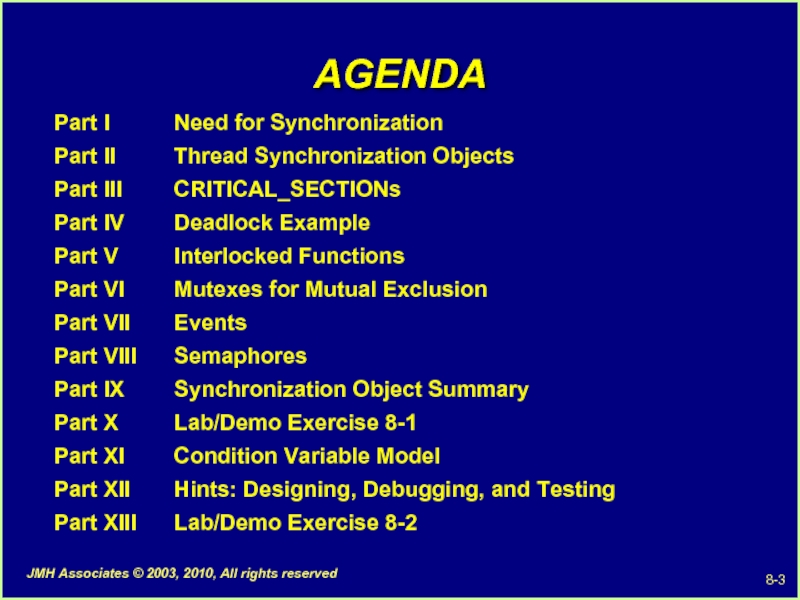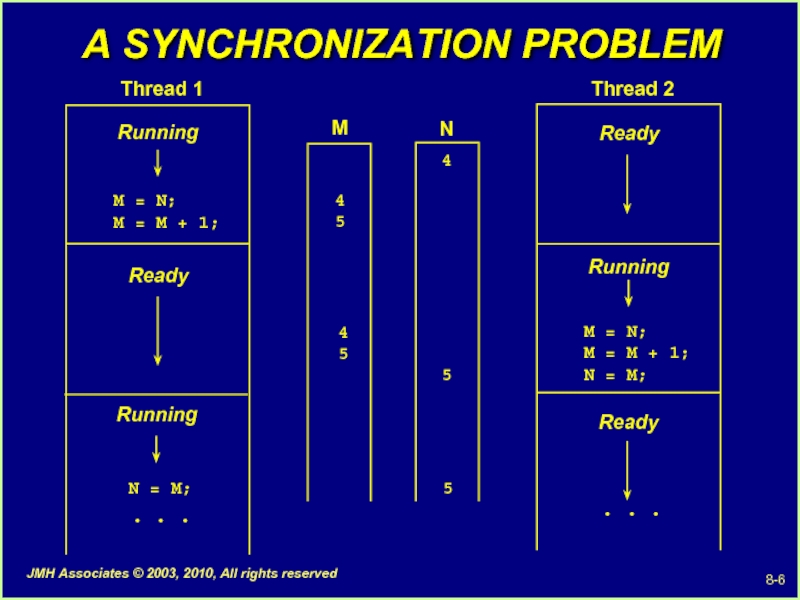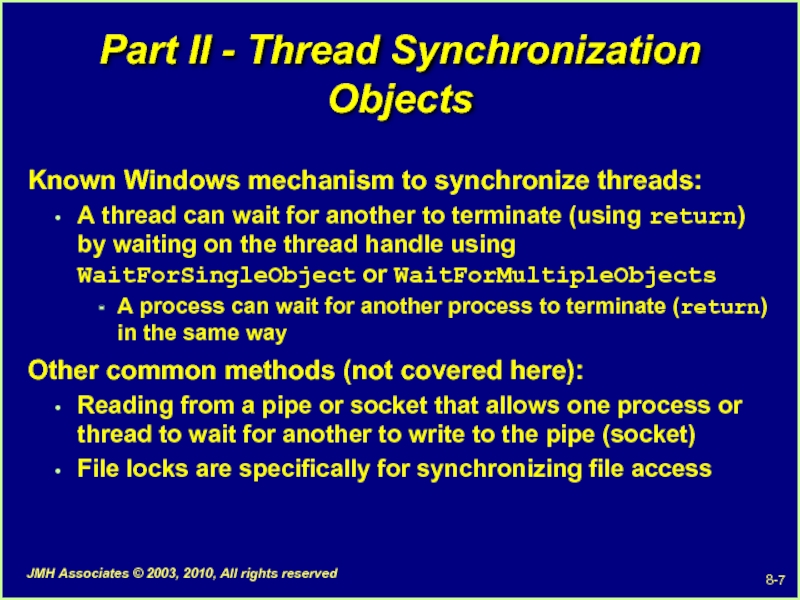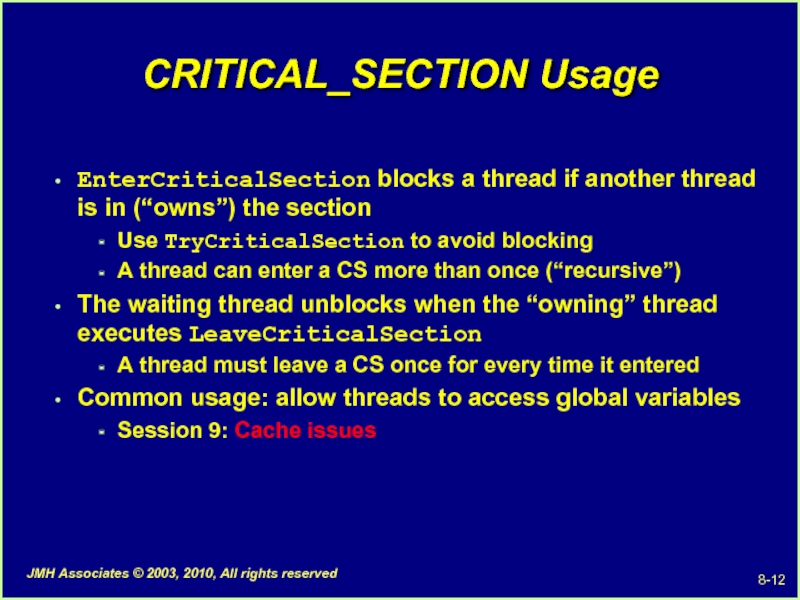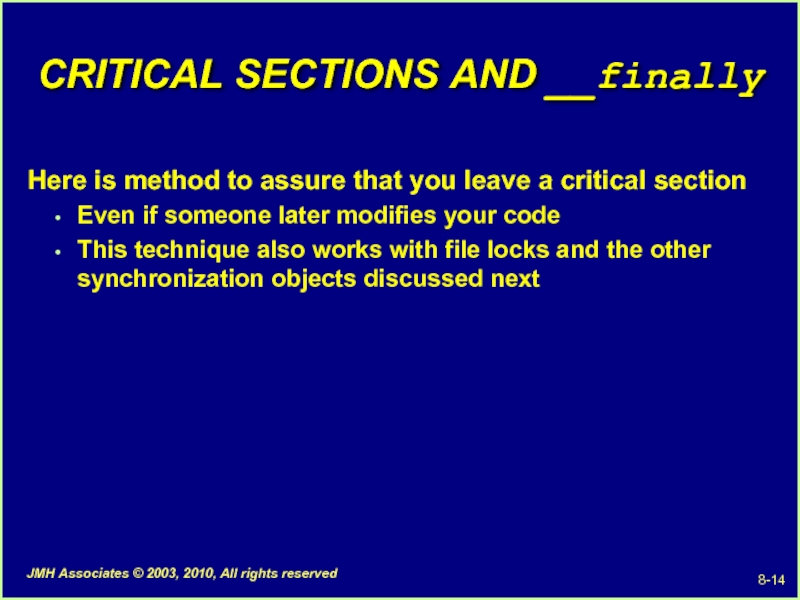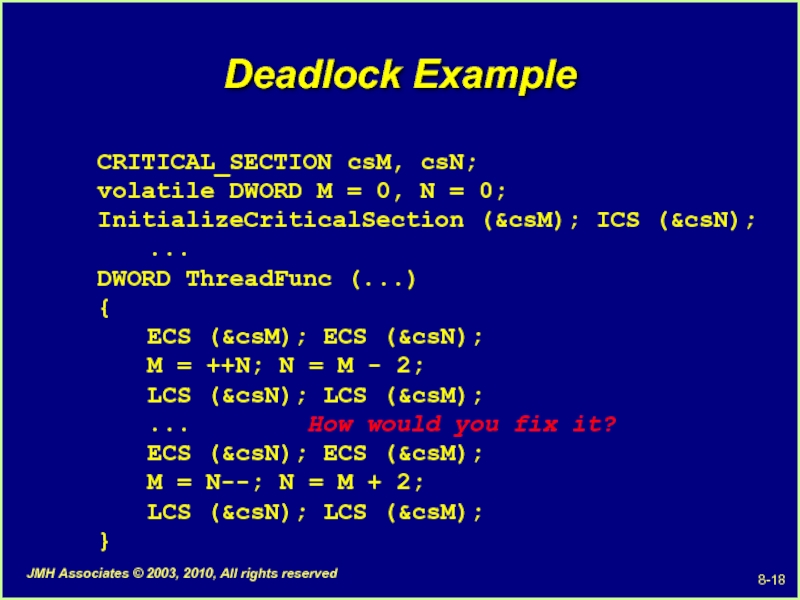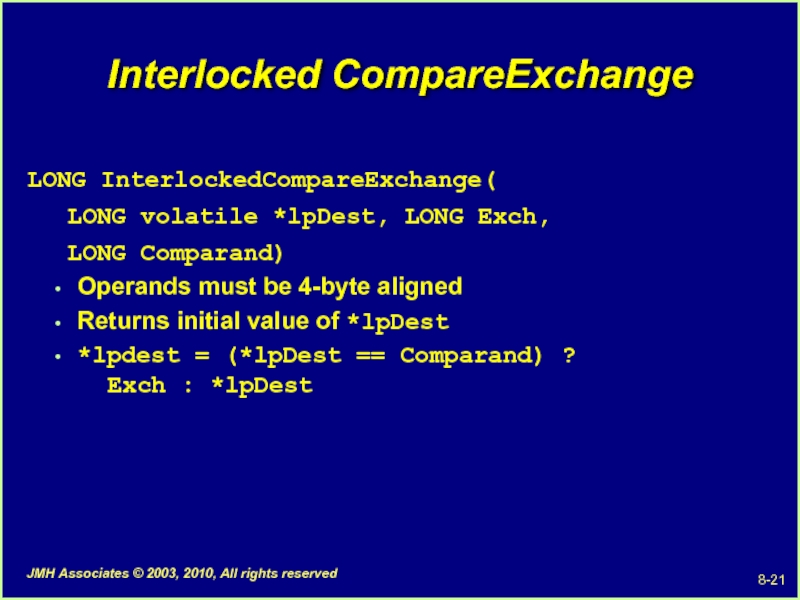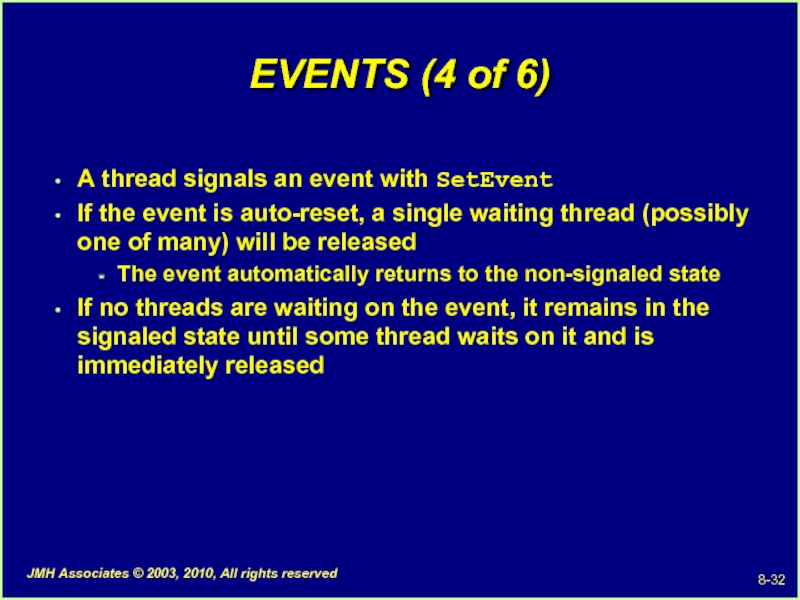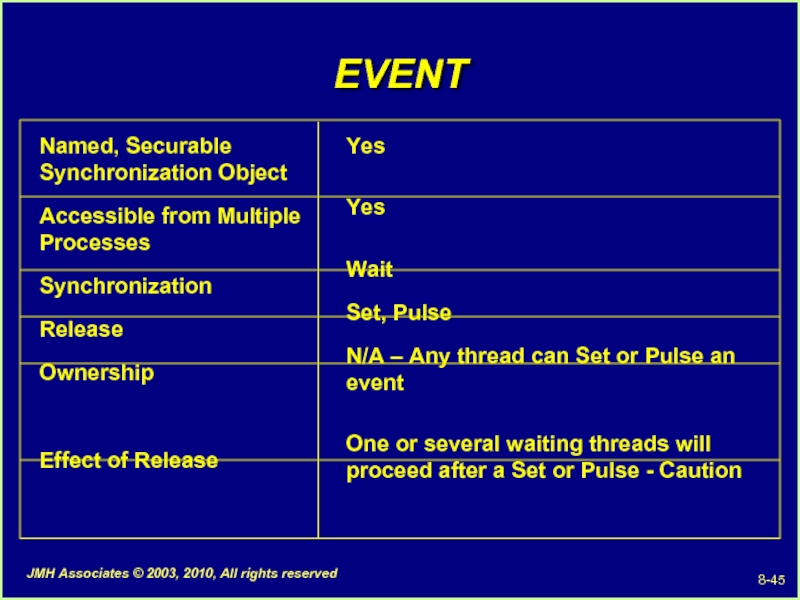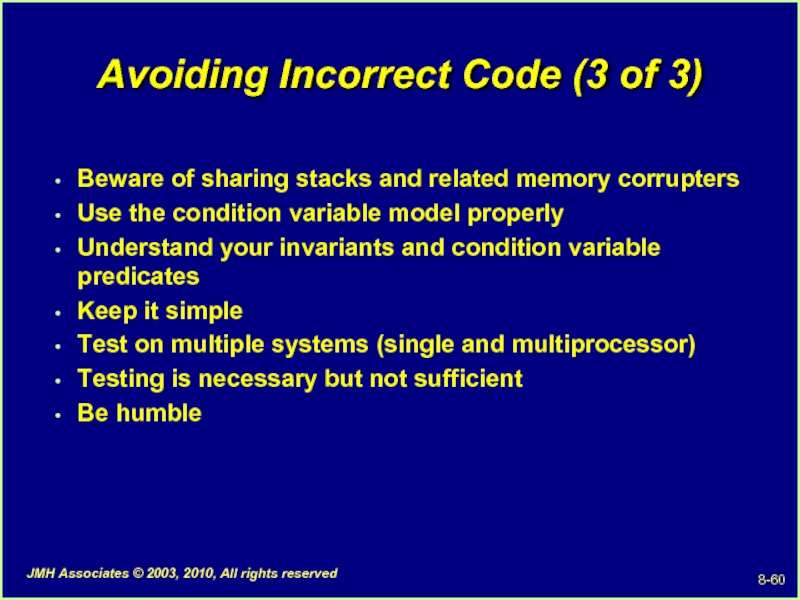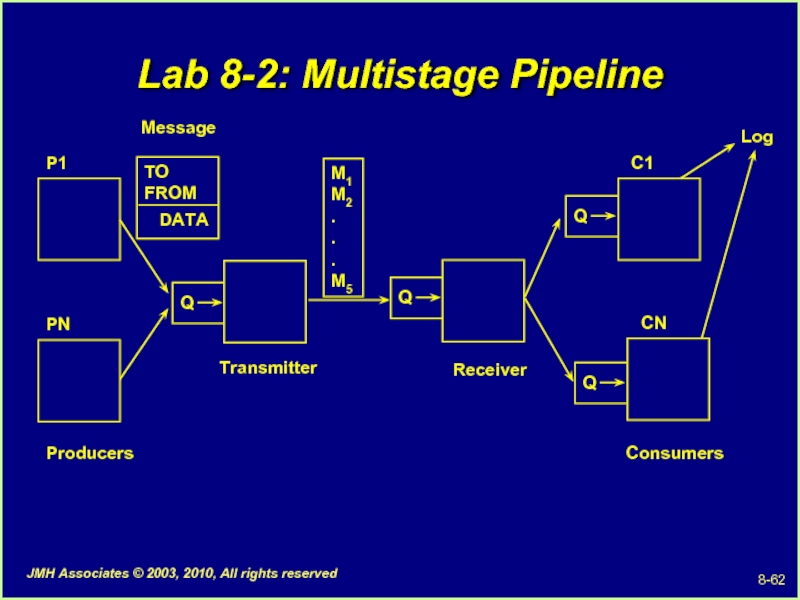- Главная
- Разное
- Дизайн
- Бизнес и предпринимательство
- Аналитика
- Образование
- Развлечения
- Красота и здоровье
- Финансы
- Государство
- Путешествия
- Спорт
- Недвижимость
- Армия
- Графика
- Культурология
- Еда и кулинария
- Лингвистика
- Английский язык
- Астрономия
- Алгебра
- Биология
- География
- Детские презентации
- Информатика
- История
- Литература
- Маркетинг
- Математика
- Медицина
- Менеджмент
- Музыка
- МХК
- Немецкий язык
- ОБЖ
- Обществознание
- Окружающий мир
- Педагогика
- Русский язык
- Технология
- Физика
- Философия
- Химия
- Шаблоны, картинки для презентаций
- Экология
- Экономика
- Юриспруденция
Windows Thread Synchronization презентация
Содержание
- 1. Windows Thread Synchronization
- 2. OBJECTIVES Upon completion of this Session, you
- 3. AGENDA Part I Need for Synchronization Part II Thread
- 4. IMPORTANT APIs IN THIS SESSION Initialize/Delete/Enter/Leave/TryCriticalSection InterlockedIncrement/Decrement/Exchange/… CreateMutex/Event/Semaphore OpenMutex/Event/Semaphore ReleaseMutex/Semaphore, Pulse/SetResetEvent SignalObjectAndWait
- 5. Part I - Need for Synchronization Why
- 6. A SYNCHRONIZATION PROBLEM M 4 5
- 7. Part II - Thread Synchronization Objects Known
- 8. Synchronization Objects Windows (pre-Vista) provides four other
- 9. Critical Section Objects Critical sections Fourth object
- 10. Part III - CRITICAL_SECTIONs VOID InitializeCriticalSection (
- 11. CRITICAL_SECTION Management VOID LeaveCriticalSection ( LPCRITICAL_SECTION lpcsCriticalSection)
- 12. CRITICAL_SECTION Usage EnterCriticalSection blocks a thread if
- 13. SYNCHRONIZATION CSs M 4 5
- 14. CRITICAL SECTIONS AND __finally Here is method
- 15. __finally (2 of 2) CRITICAL_SECTION cs;
- 16. CRITICAL_SECTION Comments CRITICAL_SECTIONS test the lock in
- 17. Part IV - Deadlock Example Here is
- 18. Deadlock Example CRITICAL_SECTION csM, csN; volatile DWORD
- 19. Part V - Interlocked Functions For simple
- 20. Interlocked Functions LONG InterlockedIncrement(LONG volatile *lpAddend) LONG
- 21. Interlocked CompareExchange LONG InterlockedCompareExchange( LONG volatile *lpDest,
- 22. Other Interlocked Functions InterlockedExchangePointer InterlockedAnd, InterlockedOr, InterlockedXor
- 23. Part VI - Mutexes (1 of 6)
- 24. Mutexes (2 of 6) Recursive: A thread
- 25. Mutexes (3 of 6) HANDLE CreateMutex(LPSECURITY_ATTRIBUTES lpsa,
- 26. Mutexes (4 of 6) BOOL ReleaseMutex(HANDLE hMutex)
- 27. Mutexes (5 of 6) Mutex naming: Name
- 28. Mutexes (6 of 6) Process interaction with
- 29. Part VII - EVENTS (1 of 6)
- 30. EVENTS (2 of 6) HANDLE CreateEvent( LPSECURITY_ATTRIBUTES
- 31. EVENTS (3 of 6) The three functions
- 32. EVENTS (4 of 6) A thread signals
- 33. EVENTS (5 of 6) If the event
- 34. EVENTS (6 of 6) When using WaitForMultipleEvents,
- 35. Event Notes Behavior depends on manual or
- 36. Part VIII - SEMAPHORES (1 of 4)
- 37. SEMAPHORES (2 of 4) Threads or processes
- 38. SEMAPHORES (3 of 4) HANDLE CreateSemaphore( LPSECURITY_ATTRIBUTES
- 39. SEMAPHORES (4 of 4) BOOL ReleaseSemaphore( HANDLE
- 40. A SEMAPHORE DEADLOCK DEFECT There is no
- 41. Part IX - Windows SYNCHRONIZATION OBJECTS Summary
- 42. CRITICAL SECTION Named, Securable Synchronization Object
- 43. MUTEX Named, Securable Synchronization Object Accessible from
- 44. SEMAPHORE Named, Securable Synchronization Object Accessible from
- 45. EVENT Named, Securable Synchronization Object Accessible from
- 46. Part X - Lab/Demo Exercise 8-1 Create
- 47. Part XI - Condition Variable Model Using
- 48. Events and Mutexes Together (1 of 2)
- 49. Events and Mutexes Together (2 of 2)
- 50. The Condition Variable Model (1 of 4)
- 51. The Condition Variable Model (2 of 4)
- 52. The Condition Variable Model (3 of 4)
- 53. The Condition Variable Model (4 of 4)
- 54. Condition Variable Model Comments Three essential steps
- 55. Using SignalObjectAndWait() /* CONSUMER thread waits for
- 56. CV Model Variation In producer/consumer code, ONE
- 57. Broadcast CV Model Consumer /* CONSUMER thread
- 58. Part XII - Multithreading: Designing, Debugging, Testing
- 59. Avoiding Incorrect Code (2 of 3) Avoid
- 60. Avoiding Incorrect Code (3 of 3) Beware
- 61. Part XIII - Lab 8-2 Debug and
- 62. Lab 8-2: Multistage Pipeline Q
- 63. Harder Exercises MultiSem – Atomic multiple wait
Слайд 2OBJECTIVES
Upon completion of this Session, you will be able to:
Describe the
Differentiate synchronization object features and how to select between them
Use synchronization in Windows applications
Слайд 3AGENDA
Part I Need for Synchronization
Part II Thread Synchronization Objects
Part III CRITICAL_SECTIONs
Part IV Deadlock Example
Part
Part VI Mutexes for Mutual Exclusion
Part VII Events
Part VIII Semaphores
Part IX Synchronization Object Summary
Part X Lab/Demo Exercise 8-1
Part XI Condition Variable Model
Part XII Hints: Designing, Debugging, and Testing
Part XIII Lab/Demo Exercise 8-2
Слайд 4IMPORTANT APIs IN THIS SESSION
Initialize/Delete/Enter/Leave/TryCriticalSection
InterlockedIncrement/Decrement/Exchange/…
CreateMutex/Event/Semaphore
OpenMutex/Event/Semaphore
ReleaseMutex/Semaphore, Pulse/SetResetEvent
SignalObjectAndWait
Слайд 5Part I - Need for Synchronization
Why is thread synchronization required? Examples:
Boss
Worker cannot proceed until its environment is initialized
A thread cannot proceed until certain conditions are satisfied. Ex:
A free buffer is available
A buffer is filled with data to be processed.
Threads must not update the same variable concurrently
Read-modify-write
Without proper synchronization, you risk defects such as:
Race conditions
Concurrent update to a single resource
Слайд 6A SYNCHRONIZATION PROBLEM
M
4
5
4
5
M = N;
M = M + 1;
Running
N = M;
Running
·
Ready
N
4
5
5
Ready
M = N;
M = M + 1;
N = M;
Running
Ready
· · ·
Thread 1
Thread 2
Слайд 7Part II - Thread Synchronization Objects
Known Windows mechanism to synchronize threads:
A
A process can wait for another process to terminate (return) in the same way
Other common methods (not covered here):
Reading from a pipe or socket that allows one process or thread to wait for another to write to the pipe (socket)
File locks are specifically for synchronizing file access
Слайд 8Synchronization Objects
Windows (pre-Vista) provides four other objects for thread and process
Three are kernel objects (they have HANDLEs)
Events
Semaphores
Mutexes
Many inherently complex problems – beware:
Deadlocks
Race conditions
Missed signals
Many more
Слайд 9Critical Section Objects
Critical sections
Fourth object type can only synchronize threads within
Often the most efficient choice
Apply to many application scenarios
“Fast mutexes”
Not kernel objects
Critical section objects are initialized, not created
Deleted, not closed
Threads enter and leave critical sections
Only 1 thread at a time can be in a critical code section
There is no handle — there is a CRITICAL_SECTION type
Слайд 10Part III - CRITICAL_SECTIONs
VOID InitializeCriticalSection (
LPCRITICAL_SECTION lpcsCriticalSection)
VOID DeleteCriticalSection (
LPCRITICAL_SECTION lpcsCriticalSection)
VOID EnterCriticalSection
LPCRITICAL_SECTION lpcsCriticalSection)
Слайд 11CRITICAL_SECTION Management
VOID LeaveCriticalSection (
LPCRITICAL_SECTION lpcsCriticalSection)
BOOL TryCriticalSection (
LPCRITICAL_SECTION lpcsCriticalSection)
Слайд 12CRITICAL_SECTION Usage
EnterCriticalSection blocks a thread if another thread is in (“owns”)
Use TryCriticalSection to avoid blocking
A thread can enter a CS more than once (“recursive”)
The waiting thread unblocks when the “owning” thread executes LeaveCriticalSection
A thread must leave a CS once for every time it entered
Common usage: allow threads to access global variables
Session 9: Cache issues
Слайд 13SYNCHRONIZATION CSs
M
4
5
N
4
M = N;
M = M + 1;
Running
Idle
Thread 1
Idle
Running
· · ·
Thread
Blocked
M = N;
M = M + 1;
N = M;
Running
ECS(&CS);
ECS(&CS);
5
5
6
6
N = M;
Running
· · ·
LCS (&CS);
LCS(&CS);
Слайд 14CRITICAL SECTIONS AND __finally
Here is method to assure that you leave
Even if someone later modifies your code
This technique also works with file locks and the other synchronization objects discussed next
Слайд 15 __finally (2 of 2)
CRITICAL_SECTION cs;
...
InitializeCriticalSection (&cs);
...
EnterCriticalSection (&cs);
_try { ... }
_finally
Слайд 16CRITICAL_SECTION Comments
CRITICAL_SECTIONS test the lock in user-space
Fast – no kernel call
But
Almost always faster than Mutexes
Factors include number of threads, number of processors, and amount of thread contention
Performance can sometimes be “tuned”
Adjust the “spin count” – more later
CSs operate using polling and the equivalent of interlocked functions
Слайд 17Part IV - Deadlock Example
Here is a program defect that could
Some function calls are abbreviated for brevity
Deadlocks are specific kind of race condition
Aways enter CSs in the same order; leave in reverse order
To avoid deadlocks, create a lock hierarchy
You can generalize this example to multiple CSs
Слайд 18Deadlock Example
CRITICAL_SECTION csM, csN;
volatile DWORD M = 0, N = 0;
InitializeCriticalSection
...
DWORD ThreadFunc (...)
{
ECS (&csM); ECS (&csN);
M = ++N; N = M - 2;
LCS (&csN); LCS (&csM);
... How would you fix it?
ECS (&csN); ECS (&csM);
M = N--; N = M + 2;
LCS (&csN); LCS (&csM);
}
Слайд 19Part V - Interlocked Functions
For simple manipulation of signed 32-bit numbers,
There are also 64-bit versions
64-bit integer access is not atomic on 32-bit systems
All operations are atomic
Operations take place in user space
No kernel call, but, a memory barrier (mistake previously)
Easy, fast, no deadlock risk
Limited to increment, decrement, exchange, exchange/add, and compare/exchange
Can not directly solve general mutual exclusion problems
Слайд 20Interlocked Functions
LONG InterlockedIncrement(LONG volatile *lpAddend)
LONG InterlockedDecrement(LONG volatile *lpAddend)
Return the resulting value
Which might change before you can use the value
LONG InterlockedExchangeAdd(InterlockedDecrement(
LONG volatile *lpAddend, LONG Increment)
Return value is the old value of *lpAddend
LONG InterlockedExchange(InterlockedDecrement(
LONG volatile *lpTarget, LONG Value)
Return value is the old value of *lpTarget
Слайд 21Interlocked CompareExchange
LONG InterlockedCompareExchange(
LONG volatile *lpDest, LONG Exch,
LONG Comparand)
Operands must be 4-byte
Returns initial value of *lpDest
*lpdest = (*lpDest == Comparand) ? Exch : *lpDest
Слайд 22Other Interlocked Functions
InterlockedExchangePointer
InterlockedAnd, InterlockedOr, InterlockedXor
8, 16, 32, and 64-bit versions
InterlockedIncrement64, InterlockedDecrement64
InterlockedCompare64Exchange128
Compares
Слайд 23Part VI - Mutexes (1 of 6)
Mutexes can be named and
They are kernel objects
They can be used for interprocess synchronization
They are owned by a thread rather than a process
Threads gain mutex ownership by waiting on mutex handle
With WaitForSingleObject or WaitForMultipleObjects
Threads release ownership with ReleaseMutex
Слайд 24Mutexes (2 of 6)
Recursive: A thread can acquire a specific mutex
Can be convenient, for example, with nested transactions
You can poll a mutex to avoid blocking
A mutex becomes “abandoned” if its owning thread terminates
Events and semaphores are the other kernel objects
Very similar life cycle and usage
Слайд 25Mutexes (3 of 6)
HANDLE CreateMutex(LPSECURITY_ATTRIBUTES lpsa,
BOOL fInitialOwner,
LPCTSTR lpszMutexName)
The fInitialOwner flag, if
It is overridden if the named mutex already exists
lpszMutexName points to a null-terminated pathname
Pathnames are case sensitive
Mutexes are unnamed if the parameter is NULL
Слайд 26Mutexes (4 of 6)
BOOL ReleaseMutex(HANDLE hMutex)
ReleaseMutex frees a mutex that the
Fails if the thread does not own it
If a mutex is abandoned, a wait will return WAIT_ABANDONED_0
This is the base value on a wait multiple
OpenMutex opens an existing named mutex
Allows threads in different processes to synchronize
Слайд 27Mutexes (5 of 6)
Mutex naming:
Name a mutex that is to be
Mutexes, semaphores, & events share the same name space
Memory mapping objects also use this name space
Also waitable timers
And, all processes share this name space
Alert: Name collisions – name carefully
Normal: Don’t name a mutex used in a single process
Слайд 28Mutexes (6 of 6)
Process interaction with a named mutex
Same name space
Process 1
Process 2
h = CreateMutex ("MName");
h = OpenMutex ("MName");
Слайд 29Part VII - EVENTS (1 of 6)
Events can release multiple threads
A manual-reset event can signal several threads simultaneously and must be reset by the thread
An auto-reset event signals a single thread, and the event is reset automatically
Signal an event with either PulseEvent or SetEvent
Four combinations with very different behavior
Be careful! There are numerous subtle problems
Recommendation: Only use with SignalObjectAndWait()
(Much) more on this later
Слайд 30EVENTS (2 of 6)
HANDLE CreateEvent(
LPSECURITY_ATTRIBUTES lpsa,
BOOL fManualReset, BOOL fInitialState,
LPTCSTR lpszEventName)
Manual-reset event:
Event is initially set to signaled if fInitialState is TRUE
Open a named event with OpenEvent
Слайд 31EVENTS (3 of 6)
The three functions for controlling events are:
BOOL SetEvent(HANDLE
BOOL ResetEvent(HANDLE hEvent)
BOOL PulseEvent(HANDLE hEvent)
Слайд 32EVENTS (4 of 6)
A thread signals an event with SetEvent
If the
The event automatically returns to the non-signaled state
If no threads are waiting on the event, it remains in the signaled state until some thread waits on it and is immediately released
Слайд 33EVENTS (5 of 6)
If the event is manual-reset, the event remains
During this time, all waiting threads are released
It is possible that other threads will wait, and be released, before the reset
PulseEvent allows you to release all threads currently waiting on a manual-reset event
The event is then automatically reset
Слайд 34EVENTS (6 of 6)
When using WaitForMultipleEvents, wait for all events to
A waiting thread will be released only when all events are simultaneously in the signaled state
Some signaled events might be released before the thread is released
Слайд 35Event Notes
Behavior depends on manual or auto reset, Pulse or Set
All 4 forms are useful
AutoReset ManualReset
SetEvent Exactly one thread is released. All currently waiting threads
If none are currently waiting released. The event remains
on the event, the next thread to signaled until reset by some
wait will be released. thread.
PulseEvent Exactly one thread is released, All currently waiting threads
but only if a thread is currently released, and the event is
waiting on the event. then reset.
Слайд 36Part VIII - SEMAPHORES (1 of 4)
A semaphore combines event and
Can be emulated with one of each and a counter
Semaphores maintain a count
No ownership concept
The semaphore object is signaled when the count is greater than zero, and the object is not signaled when the count is zero
With care, you can achieve mutual exclusion with a semaphore
Слайд 37SEMAPHORES (2 of 4)
Threads or processes wait in the normal way,
When a waiting thread is released, the semaphore’s count is incremented by one
Any thread can release
Not restricted to the thread that “acquired” the semaphore
Consider a producer/consumer model to see why
Слайд 38SEMAPHORES (3 of 4)
HANDLE CreateSemaphore(
LPSECURITY_ATTRIBUTES lpsa,
LONG cSemInitial, LONG cSemMax,
LPCTSTR lpszSemName)
cSemMax is
Must be one or greater
0 <= cSemInitial <= cSemMax is the initial value
You can only decrement the count by one with any given wait operation, but you can release a semaphore and increment its count by any value up to the maximum value
Слайд 39SEMAPHORES (4 of 4)
BOOL ReleaseSemaphore(
HANDLE hSemaphore,
LONG cReleaseCount,
LPLONG lpPreviousCount)
You can find the
The release count must be greater than zero, but if it would cause the semaphore count to exceed the maximum, the call will return FALSE and the count will remain unchanged
There is also an OpenSemaphore function
Слайд 40A SEMAPHORE DEADLOCK DEFECT
There is no “atomic” wait for multiple semaphore
But you can release multiple units atomically!
Here is a potential deadlock in a thread function
for (i = 0; i < NumUnits; i++)
WaitForSingleObject (hSem, INFINITE);
Solution: Treat the loop as a critical section, guarded by a CRITICAL_SECTION or mutex
Or, a multiple wait semaphore can be created with an event, mutex, and counter – this is an optional lab
Слайд 42CRITICAL SECTION
Named, Securable Synchronization Object
Accessible from Multiple
Processes
Synchronization
Release
Ownership
Effect of Release
No
No
Enter
Leave
One thread at
One waiting thread can enter
Слайд 43MUTEX
Named, Securable Synchronization Object
Accessible from Multiple
Processes
Synchronization
Release
Ownership
Effect of Release
Yes
Yes
Wait
Release or owner terminates
One
One waiting thread can gain ownership after last release
Слайд 44SEMAPHORE
Named, Securable Synchronization Object
Accessible from Multiple
Processes
Synchronization
Release
Ownership
Effect of Release
Yes
Yes
Wait
Any thread can release
N/A
Multiple threads can proceed, depending on release count
Слайд 45EVENT
Named, Securable Synchronization Object
Accessible from Multiple
Processes
Synchronization
Release
Ownership
Effect of Release
Yes
Yes
Wait
Set, Pulse
N/A – Any
One or several waiting threads will proceed after a Set or Pulse - Caution
Слайд 46Part X - Lab/Demo Exercise 8-1
Create two working threads: A producer
The producer periodically creates a message
The message is checksummed
The consumer prompts the user for one of two commands
Consume the most recent message – wait if necessary
Stop
Once the system is stopped, print summary statistics
Start with eventPC_x.c. A correct solution is provided
simplePC.c is similar, but simpler. It also uses a CS
Note how the mutex/CS guards the data object
Note how the event signals a change in the data object
Слайд 47Part XI - Condition Variable Model
Using Models (or Patterns)
Use well-understood and
Aid development, understanding and maintenance
“Boss/worker” and “work crew” models
Critical section essential for mutexes
Even defects have models (deadlocks)
“Anti-pattern”
Helps to understand and control event behavior
Слайд 48Events and Mutexes Together (1 of 2)
Similar to POSIX Pthreads
Illustrated with
The mutex and event are both associated with the message block data structure
The mutex defines the critical section for accessing the message data structure object
Assures the object’s invariants
The event is used to signal that there is a new message
Signals that the object has changed to a specified state
Слайд 49Events and Mutexes Together (2 of 2)
One thread (producer) locks the
Changes the object’s state by creating a new message
Sets or pulses the event – new message
One or more threads (consumers) wait on the event for the object to reach the desired state
The wait must occur outside the critical section
A consumer thread can also lock the mutex
And test the object’s state
Слайд 50The Condition Variable Model (1 of 4)
Several key elements:
Data structure of
Contains all the data such as messages, checksums, etc.
A mutex and one or more events associated with the data structure
One or more Boolean functions to evaluate the “condition variable predicates”
For example, “a new message is ready”
An event is associated with each condition variable predicate
Слайд 51The Condition Variable Model (2 of 4)
typedef struct _state_t {
HANDLE CvpSet;
/* Autoreset Event for “signal” model */
. . . other condition variables
/* State structure with counts, etc. */
struct STATE_VAR_TYPE StateVar;
} STATE_TYPE State;
. . .
/* Initialize State, creating mutex and event */
. . .
Слайд 52The Condition Variable Model (3 of 4)
/* This is the “Signal”
/* PRODUCER thread that modifies State */
WaitForSingleObject(State.Guard, INFINITE);
/* Change state so that the CV predicate holds */
. . . State.StateVar.xyz = . . . ;
SetEvent (State.CvpSet); /* Signal one consumer */
ReleaseMutex (State.Guard);
/* End of the interesting part of the producer */
. . .
Слайд 53The Condition Variable Model (4 of 4)
/* CONSUMER thread waits for
WaitForSingleObject(State.Guard, INFINITE);
while (!cvp(&State)) {
ReleaseMutex(State.Guard);
WaitForSingleObject(State.CvpSet, TimeOut);
WaitForSingleObject(State.Guard, INFINITE);
}
. . .
ReleaseMutex(State.Guard);
/* End of the interesting part of the consumer */
Alert
Слайд 54Condition Variable Model Comments
Three essential steps of the loop in the
Unlock the mutex
Wait on the event
Lock the mutex again
Note: Pthreads (UNIX) combines these into a single function. Windows does this in NT 6.x (Next session)
Windows SignalObjectAndWait performs the first two steps atomically – NT 5.x (there’s still legacy code that avoids SOAW)
No timeout and no missed signal
Слайд 55Using SignalObjectAndWait()
/* CONSUMER thread waits for NEXT state change */
/* Use
WaitForSingleObject (State.Guard, INFINITE);
do {
SignalObjectAndWait(State.Guard,
State.CvpSet, INFINITE);
WaitForSingleObject (State.Guard, INFINITE);
} while (!cvp(&State));
/* Thread now owns the mutex and cvp(&State) holds */
/* Take appropriate action, perhaps modifying State */
. . .
ReleaseMutex (State.Guard);
/* End of the interesting part of the consumer */
Слайд 56CV Model Variation
In producer/consumer code, ONE consumer is released
Signal CV model
Auto-reset
Or, there may be only one message available and multiple consuming threads – broadcast CV model
Event should be manual-reset
Producer should call PulseEvent
Assure exactly one thread is released
Careful: Risk of missed signal, even with SOAW
You need the timeout – consumer thread could preempt the thread and the signal could be missed
NT 6.x has a real condition variable (at last)
CV model is basic in POSIX Pthreads
Слайд 57Broadcast CV Model Consumer
/* CONSUMER thread waits for NEXT state change
/* Event is manual-reset */
WaitForSingleObject (State.Guard, INFINITE);
do {
SignalObjectAndWait(State.Guard,
State.CvpSet, TimeOut);
WaitForSingleObject (State.Guard, INFINITE);
} while (!cvp(&State));
/* Thread owns the mutex and cvp(&State) holds */
. . .
ReleaseMutex (State.Guard);
/* End of the interesting part of the consumer */
Слайд 58Part XII - Multithreading: Designing, Debugging, Testing Hints
Avoiding Incorrect Code (1
Pay attention to design, implementation, and use of familiar programming models
The best debugging technique is not to create bugs in the first place – Easy to say, harder to do
Many serious defects will elude the most extensive and expensive testing
Debuggers change timing behavior
Masking the race conditions you wish to expose
Слайд 59Avoiding Incorrect Code (2 of 3)
Avoid relying on “thread inertia”
Never bet
Scheduling is not the same as synchronization
Sequence races can occur
Even when you use mutexes to protect shared data
Cooperate to avoid deadlocks
Never share events between predicates
Слайд 60Avoiding Incorrect Code (3 of 3)
Beware of sharing stacks and related
Use the condition variable model properly
Understand your invariants and condition variable predicates
Keep it simple
Test on multiple systems (single and multiprocessor)
Testing is necessary but not sufficient
Be humble
Слайд 61Part XIII - Lab 8-2
Debug and test the ThreeStage pipeline implementation
Two
The Compete directory has numerous alternative implementations of QueueObj.c. As an alternative to fixing the defective version, time and compare the alternative solutions
Also, check out the variants: QueueObjCS.c, etc.
Add thread cancelation (see ThreeStageCancel, QueueObjCancel) – discuss & Supplemental Session 9
Idea: Use a real signature on the messages – performance impact?
Alternative: Port the Pthreads implementation
There is an open source library, but don’t use it
Слайд 62Lab 8-2: Multistage Pipeline
Q
Q
Transmitter
Receiver
Consumers
Q
M1
M2
.
.
.
M5
P1
Producers
PN
Message
TO
FROM
DATA
Log
C1
CN
Слайд 63Harder Exercises
MultiSem – Atomic multiple wait semaphore
The solution must also work
This will require memory mapping
There are x, xx, and xxx versions
compMP
Windows CMD utility to compare files
Find first 8 (arbitrary) different bytes & report in order
Requires “speculative processing”
My solution is much faster than the CMD version and it scales well with processor count
x, xx, and xxx versions


